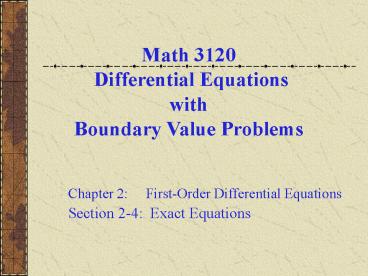Math 260 - PowerPoint PPT Presentation
1 / 15
Title:
Math 260
Description:
Integrate to find Write down the function All the solutions are given by the implicit equation If you are given an IVP, ... partial differential equation ... Math 260 ... – PowerPoint PPT presentation
Number of Views:97
Avg rating:3.0/5.0
Title: Math 260
1
Math 3120 Differential Equations withBoundary
Value Problems
Chapter 2 First-Order Differential
Equations Section 2-4 Exact Equations
2
Exact Equations
- Consider a first order ODE of the form
- Suppose there is a function ? such that
- and such that ?(x,y) c defines y ?(x)
implicitly. Then - and hence the original ODE becomes
- Thus ?(x,y) c defines a solution implicitly.
- In this case, the ODE is said to be exact.
3
Theorem 2.4.1
- Suppose an ODE can be written in the form
- where the functions M, N, My and Nx are all
continuous in the rectangular region R (x, y) ?
(?, ? ) x (?, ? ). Then Eq. (1) is an exact
differential equation iff - That is, there exists a function ? satisfying
the conditions - iff M and N satisfy Equation (2).
4
Method to solve Exact Equations
- Write the DE in the form
- Check if the eq. (1) is an exact differential
equation. - Write down the system of eq.
- Integrate either the first equation with respect
of the variable x or the second with respect of
the variable y. The choice of the equation to be
integrated will depend on how easy the
calculations are. Let us assume that the first
equation was chosen, then we get - Use the second equation of the system to find the
derivative of g(y). - Integrate to find
- Write down the function
- All the solutions are given by the implicit
equation - If you are given an IVP, plug in the initial
condition to find the constant C.
5
Example 1 Exact Equation (1 of 4)
- Consider the following differential equation.
- Then
- and hence
- From Theorem 2.4.1,
- Thus
6
Example 1 Solution (2 of 4)
- We have
- and
- It follows that
- Thus
- By Theorem 2.6.1, the solution is given
implicitly by
7
Example 1 Direction Field and Solution Curves
(3 of 4)
- Our differential equation and solutions are given
by - A graph of the direction field for this
differential equation, - along with several solution curves, is given
below.
8
Example 1 Explicit Solution and Graphs (4 of 4)
- Our solution is defined implicitly by the
equation below. - In this case, we can solve the equation
explicitly for y - Solution curves for several values of c are given
below.
9
Example 2 Exact Equation (1 of 3)
- Consider the following differential equation.
- Then
- and hence
- From Theorem 2.4.1,
- Thus
10
Example 2 Solution (2 of 3)
- We have
- and
- It follows that
- Thus
- By Theorem 2.6.1, the solution is given
implicitly by
11
Example 2 Direction Field and Solution Curves
(3 of 3)
- Our differential equation and solutions are given
by - A graph of the direction field for this
differential equation, - along with several solution curves, is given
below.
12
Example 3 Non-Exact Equation
- Consider the following differential equation.
- Then
- and hence
13
Integrating Factors
- It is sometimes possible to convert a
differential equation that is not exact into an
exact equation by multiplying the equation by a
suitable integrating factor ?(x, y) - For this equation to be exact, we need
- This partial differential equation may be
difficult to solve. If ? is a function of x
alone, then ?y 0 and hence we solve - provided right side is a function of x only.
Similarly if ? is a function of y alone.
14
Summarize
- Given a first ODE by
- If is a function of x
alone, then an integrating factor for (1) is - If is a function of y
alone, then an integrating factor for (1) is
15
Example 4 Non-Exact Equation
- Consider the following non-exact differential
equation. - Seeking an integrating factor, we solve the
linear equation - Multiplying our differential equation by ?, we
obtain the exact equation - which has its solutions given implicitly by































